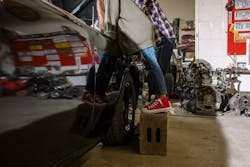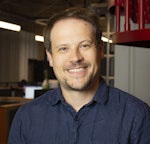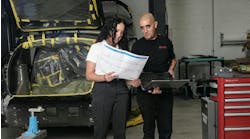You hear it from any industry: How can management know what employees really need if they’ve never been in their shoes? At CARSTAR Fort Collins in Colorado, the employee perspective was considered from the first line on a blueprint for their new facility that opened nearly two years ago. That’s because owner Doug Kaltenberger designed the shop based on his 30 years of experience as a technician.
While not designed from the ground up for collision repair, the former granite storage facility provided just the blank slate necessary for Kaltenberger to craft the ideal shop. That means workstations with all the essentials a technician might need such as air hoses, in-ground lifts and specialty lighting. Kaltenberger has owned the business since 1989 but took the opportunity with his new space to finally build a shop the way he wanted it.
“One of the things Doug always said while he was building this was like, ‘At my age I don't know why the hell I'm doing this, but it’s my dream so I'm going to do it,’” says General Manager Tylor Balistreri. “So it's just so many like little things that you don't really think about unless you’ve, like, actually physically worked on cars.”
Balistreri describes the building as essentially one big box, with two garage doors on each side. That gave plenty of design freedom to craft the inside. Bays line the north and south side with a large aisle in the middle for vehicle flow. Curtains help separate areas to limit dust and noise and tools are placed so that techs never have to travel far to get what they need.
Just as important as the physical design of the space is the processes that utilize that space to maximum efficiency. It’s a process that’s been evolving under the entire history of Kaltenberger’s ownership, and the result is that CARSTAR Fort Collins reports cycle times two days faster than the average for shops in Colorado. Maintaining that process is one of the areas of expertise of Balistreri, whose first association with the shop was renting its customers cars as an employee of Enterprise. In making the jump to shop leadership, Balistreri did his share of self-education.
“I just kind of took it upon myself to utilize the same training that my technicians had, just so I knew what was going on myself,” says Balistreri. “I kind of always joke, like, I don't know how to do the weld, but I definitely know where it should be welded and what that weld should look like.”
Balistreri credits resources from CARSTAR’s EDGE Performance Group (EPG) in which he was able to learn from other owners and tour facilities. Many of the shop’s processes that Kaltenberger developed sprang from EPG and continue to guide the shop today. Summarized simply by Balistreri, everything in the shop has a place.
Color coordination of projects is a big priority in the shop. Take a look at the back lot and every parking space is labeled. Balistreri gestures behind his desk to row after row of file folders of varying colors, green, orange, red, yellow and more. Green is for fast track jobs, orange for hail damage, red for large jobs and so forth.
“So there's just so many visual cues around our shop to make sure that everyone knows exactly what's going on just by looking at it at a glance,” says Balistreri.
The shop also uses mapping within its CCC software. The map takes a blueprint of the shop and allows anyone to track vehicles as they move through the repair process. Color comes in again to indicate whether a job is on track or falling behind.
One additional pop of color employees see in the shop is flags on the vehicles to indicate the insurer. State Farm is one of the shop’s biggest customers. Red flags indicate State Farm vehicles so that managers have an immediate visual sense walking around the lot how many of those jobs are in waiting.
“There's just so many different cues that we use to just be as efficient as possible in our shop,” Balistreri says.”
While the shop’s processes have been developed and honed through years of Kaltenberger’s ownership, the business has also made use of CARSTAR’s “Five S System.” The five S’s are straightening, shining, systemizing, sustaining and supporting, but Balistreri summarizes it as a system of organizing and for ensuring that things stay organized. That’s the “sustaining” part that they take the most seriously, as the business already had a process worth keeping.
With the shop in sustain mode for so long, Kaltenberger is able to be in and out of the shop knowing that the process will keep things on track. When he comes in and something isn’t on track, it’s obvious right away and can be corrected. That makes everyone’s job easier.
“I've been in Doug’s shop for about five and a half years now, and we've been on the sustain side of things the entire time, which is really nice,” says Balistreri. “I just have to make sure things stay in place. It's always kind of funny, because Doug’s kind of in and out. And so when he comes in, he’ll maybe see something that isn't exactly where it should be … because he's just been doing it for so long. He could just like walk through the shop and come back to me with five things that I need to go take a look at.”
No matter how strong a process is, it’s never self-sustaining. It takes effort from everyone involved and constant reminders to maintain. New employees are never sent off on their own without learning under another technician for at least a month. That’s so process becomes not just learned but second nature.
No process is ever perfect, either. That’s why shops like CARSTAR Fort Collins often elicit feedback from employees. They also learn from mistakes the employees make and work together to see if that was a one-time accident or a fault in the process. Any changes then involve the technicians who are going to be working within those processes.
“It's not so much about, like, pointing fingers as much as it is about, like, identifying issues and solving them together,” says Balistreri. “Then it just changes the whole perspective on how you solve problems in your shop and get better.”





